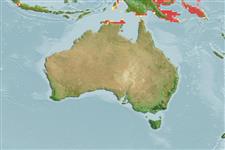>
Ovalentaria/misc (Various families in series Ovalentaria) >
Pseudochromidae (Dottybacks) > Congrogadinae
Etymology: Congrogadus: Latin, conger = conger + Latin, gadus = a fish, perhaps cod (Ref. 45335).
More on author: Weber.
Environment: milieu / climate zone / depth range / distribution range
Ökologie
seewasser demersal. Tropical; 5°S - 12°S
Western Pacific: presently known only from Aru Islands, Indonesia and Torres Strait, Australia; also known from Papua New Guinea (Ref. 6192).
Size / Gewicht / Alter
Maturity: Lm ? range ? - ? cm
Max length : 7.1 cm SL Männchen/unbestimmt; (Ref. 531)
Rückenflossenstacheln (insgesamt) : 1; Rückenflossenweichstrahlen (insgesamt) : 60 - 63; Afterflossenstacheln: 0; Afterflossenweichstrahlen: 49 - 53; Wirbelzahl: 64 - 68. Opercle with a dark ocellated spot. Gill membranes fused to the isthmus. No posterior otic sensory pore; preopercular pores 7; one posterior interorbital pore. Scaled cheek; variable number of scales dorsally on opercle. A short dark bar running posteroventrally from eye to opercular ocellus. Spots arranged in 5-6 irregular rows.
Feeds mainly on crustaceans. Eggs with cruciform hooks on the surface. Inhabits coral reefs among crevices (Ref 90102).
Life cycle and mating behavior
Geschlechtsreife | Fortpflanzung | Ablaichen | Eier | Fecundity | Larven
Winterbottom, R., 1985. Revision and vicariance biogeography of the subfamily Congrogadidae (Pisces: Perciformes: Pseudochromidae). Indo-Pac. Fish. (9):34 p. (Ref. 531)
IUCN Rote Liste Status (Ref. 130435: Version 2024-1)
Bedrohung für Menschen
Harmless
Nutzung durch Menschen
Tools
Zusatzinformationen
Download XML
Internet Quellen
Estimates based on models
Phylogenetic diversity index (Ref.
82804): PD
50 = 0.5156 [Uniqueness, from 0.5 = low to 2.0 = high].
Bayesian length-weight: a=0.00102 (0.00046 - 0.00225), b=3.06 (2.88 - 3.24), in cm total length, based on all LWR estimates for this body shape (Ref.
93245).
Trophic level (Ref.
69278): 3.5 ±0.50 se; based on food items.
Fishing Vulnerability (Ref.
59153): Low vulnerability (10 of 100).
